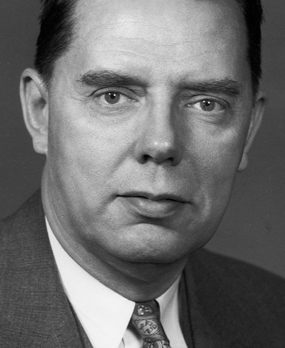How has he transformed the scene?
Young Dr. Philip S. Hench was part of what would later be called “The Rowntree Group,” a handful of promising physicians and clinical investigators recruited to the Mayo Clinic by Dr. Leonard Rowntree, who in 1920 became the Mayo Clinic’s Chief of Medicine. When Hench accepted Rowntree’s offer, he had no way of knowing the great leaps of medical discovery that would be attributed to this group in the following decades, nor the mark that he himself would make in the annals of medical history.
“Your contributions have already fulfilled the hopes of therapeutic successes in a field hitherto almost inaccessible.”
Robin Fahraeus, addressing Hench and fellow laureates Kendall and Reichstein upon receipt of the Nobel Prize in Physiology or Medicine, 1950.
Hench’s particular interest was in arthritic diseases, a field then just emerging as a specialty. He served as Mayo’s first rheumatologist and in 1926 was appointed director of the Clinic’s new Division of Rheumatology.
Many of his patients struggled with chronic, unremitting pain with little hope of remission. But Hench noted episodes of relief that he realized were not at all random. Two conditions—jaundice and pregnancy—were often associated with temporary but dramatic reduction in pain.
Appreciating the pattern, Dr. Hench wondered at the cause. He consulted with Mayo colleagues on the matter, among them biochemist Dr. Edward Kendall. What could be the common factor between the two conditions of jaundice and pregnancy? Was there an agent—he called it “substance x”—created or increased in supply by both conditions, perhaps something naturally occurring in the body? Most importantly, might it make rheumatoid arthritis a reversible condition?
Over a 12-year period in the late 1930s and early 40s Hench and Kendall conferred on the issue with increasing frequency. At the time, Kendall (who earlier had famously isolated thyroxine) was working with colleagues to isolate hormones from the human adrenal gland. Four of these compounds were of special interest by virtue of their physiologic activity, e.g. their influence on functions such as metabolism, resistance to toxicity and muscle response as demonstrated in trials on animals. These were identified simply as A, B, E and F. Many in the scientific community believed their potential therapeutic applications, if any, were likely limited to treatment of adrenal insufficiencies, such as Addison’s disease.
Nevertheless, Drs. Kendall and Hench agreed during a 1941 discussion that it was a worthwhile endeavor to see whether one of these adrenal hormones—in particular, Compound E—might in fact be Hench’s long sought-after “substance x.” But years of hurdles had to be overcome, not the least of which was the need to devise methods for partial synthesis of the hormones in a laboratory setting in order to produce sufficient quantities even for clinical trial. The pharmaceutical company Merck took up the challenge.
Finally, in September of 1948, Kendall worked through the necessary channels to obtain a small amount of Compound E for Hench and his associates to administer to a patient with rheumatoid arthritis.
Early results were nothing less than astounding. Within four days, Dr. Hench’s formerly wheelchair-bound patient walked out of the hospital. Over the next months, additional patients received the compound, now called cortisone, many to similar good effect. It appeared that Hench had indeed found his “substance X.” Although Hench, Kendall and their Mayo associates viewed the results as preliminary findings only, news reports in the New York Times broke the story of the promising new treatment around the world.
Along with the medical community at large, Hench would learn that cortisone was not a cure for rheumatoid arthritis, and there were limits to its long-term use. But the breakthrough led to the use of cortisone in many therapies. As of November 1950 it would become broadly available to American physicians, who continued to explore its capacity to reduce pain by addressing inflammation associated with an array of conditions.
By December of 1950 Hench was on his way to Sweden to receive his share of that year’s Nobel Prize in Physiology or Medicine. The award, he said, “belonged truly to all the men and women of the Mayo Clinic because it was the spirit of co-operative endeavor, the fundamental credo of the institution, which made possible the work that resulted in the trip to Stockholm.”
Dr. Hench retired from the Mayo Clinic in 1957 and died in 1965. A multi-faceted man defined by more than his role in the story of cortisone, Dr. Philip Hench was a compassionate physician of the highest caliber, a teacher, writer, medical historian and lifelong scholar. During wartime he served as Chief of the Medical Service and Director of the Rheumatism Center at the Army/Navy General Hospital. In the years following his receipt of the Nobel Prize, he was tapped to play a major role in establishing the new Department of Arthritis and Metabolism in the National Institutes of Health, he launched and edited the influential “Annual Rheumatism Reviews” and, along with his wife, was honored with an invitation to the White House to dine with President John F. Kennedy. Hench’s keen interest in medical history led him to undertake two decades of primary research into the story of the U.S. Army’s Yellow Fever Commission. He painstakingly amassed information through literature searches and personal interviews in Cuba and the United States, compiling what is now widely considered the most accurate record available on the complex story of the conquest of yellow fever.
As a sideline to his illustrious career in medicine, Hench was an active member of the “Baker Street Irregulars Society,” a group of dedicated devotees of Sherlock Holmes. His collection of first editions and related materials, now housed within the Special Collections and Rare Books at the University of Minnesota, has been described by curators as “one of the more remarkable Sherlockian libraries ever assembled.” Not surprising, of course, that Dr. Philip Hench would be a man who liked his mysteries.

